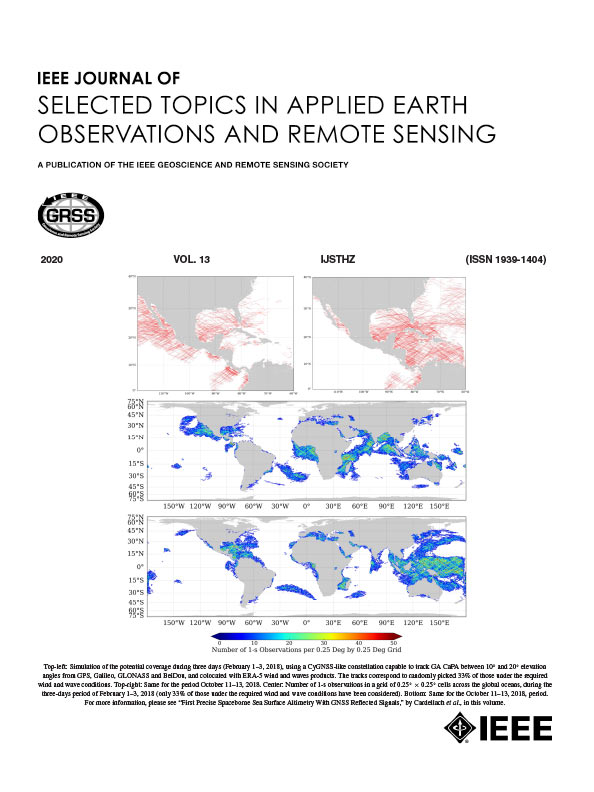高光谱图像去噪的混合状态空间模型及注意事项
IF 4.7
2区 地球科学
Q1 ENGINEERING, ELECTRICAL & ELECTRONIC
IEEE Journal of Selected Topics in Applied Earth Observations and Remote Sensing
Pub Date : 2025-03-28
DOI:10.1109/JSTARS.2025.3556024
引用次数: 0
摘要
高光谱图像(hsi)具有明显的空间相似性和光谱相关性。考虑到这两种物理性质,从噪声图像中更容易推导出基本的干净HSI。然而,现有的去噪方法难以对空间-光谱结构进行建模,主要存在以下局限性:在进行全局建模时内存消耗过大,在进行局部建模时有效性不足。为了解决这些问题,在本文中,我们提出了HyMatt,一种用于HSI去噪的状态空间模型和注意机制的混合模型。具体来说,为了充分利用HSI多维数据集中的全局相似性,我们设计了基于精心设计的多维数据集选择扫描(CSS)的视觉Mamba四边形方向,以高效内存的方式捕获远程依赖关系。我们的CSS不仅增强了全局建模能力,而且减轻了SSM固有的因果建模的负面影响。此外,为了改进局部相似度建模,我们集成了一个局部关注模块,该模块通过自适应地利用相似的相邻特征作为指导来改进相邻元素。与现有方法相比,我们的HyMatt在利用整个HSI多维数据集中的全局相似性的同时,擅长利用局部特征。在模拟和真实遥感噪声图像上进行的大量实验表明,HyMatt始终优于最先进的hsi去噪方法。本文章由计算机程序翻译,如有差异,请以英文原文为准。
A Hybrid Model of State-Space Model and Attention for Hyperspectral Image Denoising
Hyperspectral images (HSIs) exhibit pronounced spatial similarity and spectral correlation. With these two physical properties taken into account, underlying clean HSI will be easier to derive from noisy images. However, existing denoising approaches struggle to model the spatial-spectral structure due to the following limitations: excessive memory consumption when performing global modeling, and insufficient effectiveness in local modeling. To address these issues, in this article, we propose HyMatt, a hybrid model of the state-space model and attention mechanism for HSI denoising. Specifically, to fully exploit global similarity within an HSI cube, we devise vision Mamba quad directions based on crafted cube selective scan (CSS) to capture long-range dependencies in a memory-efficient manner. Our CSS not only enhances global modeling capacity but also mitigates the negative impacts of causal modeling inherent in the SSM. Furthermore, in order to improve local similarity modeling, we integrate a local attention module, in which the adjacent elements are refined by adaptively utilizing similar neighboring features as guidance. Compared to existing methods, our HyMatt excels in exploiting local features while leveraging the global similarity within the entire HSI cube. Extensive experiments on both simulated and real remote sensing noisy images demonstrate that our HyMatt consistently surpasses the state-of-the-art HSIs denoising methods.
求助全文
通过发布文献求助,成功后即可免费获取论文全文。
去求助
来源期刊
CiteScore
9.30
自引率
10.90%
发文量
563
审稿时长
4.7 months
期刊介绍:
The IEEE Journal of Selected Topics in Applied Earth Observations and Remote Sensing addresses the growing field of applications in Earth observations and remote sensing, and also provides a venue for the rapidly expanding special issues that are being sponsored by the IEEE Geosciences and Remote Sensing Society. The journal draws upon the experience of the highly successful “IEEE Transactions on Geoscience and Remote Sensing” and provide a complementary medium for the wide range of topics in applied earth observations. The ‘Applications’ areas encompasses the societal benefit areas of the Global Earth Observations Systems of Systems (GEOSS) program. Through deliberations over two years, ministers from 50 countries agreed to identify nine areas where Earth observation could positively impact the quality of life and health of their respective countries. Some of these are areas not traditionally addressed in the IEEE context. These include biodiversity, health and climate. Yet it is the skill sets of IEEE members, in areas such as observations, communications, computers, signal processing, standards and ocean engineering, that form the technical underpinnings of GEOSS. Thus, the Journal attracts a broad range of interests that serves both present members in new ways and expands the IEEE visibility into new areas.

 求助内容:
求助内容: 应助结果提醒方式:
应助结果提醒方式:


